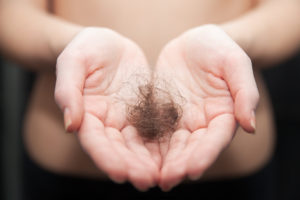“It was terrifying when it first started. I had a handful of hair – I was literally shaken with fear.”
This was the reaction Jada Pinkett Smith had when she shared recently that she’s battling hair loss. As a hair replacement professional, it’s a reaction I’ve witnessed for years, and it’s just the beginning of the gamut of emotions experienced by anyone who’s had to face the hair-loss demon.
When turbans become your new obsession. pic.twitter.com/Z772QHFXH1
— Jada Pinkett Smith (@jadapsmith) February 24, 2018
I started losing my hair as a child; I still have vivid memories of combing through my already-thin hair and watching huge clumps fall to the floor. And as I grew older, when those small clumps began to morph into large bald patches throughout my head, my only option was to struggle with making ill-fitting, poorly made wigs in hopes that I would once again look normal. It didn’t work—my baldness and the obvious wigs I was wearing made me an easy target for schoolyard bullies.
I didn’t have the ability to explain to the world what was happening to me, and I didn’t learn until later in life that the hair loss I was suffering from was a result of hereditary alopecia areata. But what the experience did give me was the will to stand up and be strong, regardless of the obstacle I was facing. I had to make a choice—let this disease overtake my mind and soul or accept that though it had already taken away a part of my body, I could still stand tall and choose my own destiny.
So when I listened to Smith describe in her ordeal the moment she faced the same decisions I did as a child, I was glad to hear that she too chose to be strong. Like the 30 million American women who’ve walked her path, she made it clear that, although we face a sense of devastation at the thought of losing what is for many of us a connection to beauty, femininity, and a personal expression of who we are, we can survive and overcome. Noting that she was fortunate enough not to be suffering from a corresponding physical illness or recovering from a life-altering event, Smith looked out from under one of the many headwraps she’s donned recently to help her manage her hair loss and said proudly, “the Lord is choosing only to take my hair? When I look at it that way I’m able to accept it.”
WATCH: Jada Pinkett Smith talks about her battle with hair loss
https://www.youtube.com/watch?v=n0TIv6nIYFo&feature=youtu.be
I’ve said for years that hair loss doesn’t discriminate—it can happen to any one of us at any time, for any reason. The truth is that many of us never expect to lose our hair—we assume it only happens to other people—those who for example are physically ill or undergoing extensive medical treatment.
But the reality is there’s often no rhyme or reason for the sudden onset of hair loss. I’ve treated women with zero histories of hair loss in their family who come from long lines of women with healthy hair. And then one day, with no warning, they start to go bald. A young woman on Twitter recently called out major hair and beauty product manufacturers never consider that their customers can lose their hair, even though statistics show that millions of women are suffering some form of hair loss. She explains it this way: “Brands that mock and laugh at the issue of hair loss when a large number of their clients are sufferers…why?”
Good question.

Here’s my advice: act now to be better prepared later— don’t wait until you or someone you know is elected into the hair loss club. I’ve shared on many occasions the fact that I was the family member who “won” the hair-loss lottery. I only wished I had at that time access to the information women have today. You can avoid experiencing what I, Jada Pinket Smith and millions of other women experienced in our hair loss battles by doing these 3 simple things:
Embrace and Accept. Then Act.
I’ve often said that our hair is as unique as our DNA. When my hair started falling out in my childhood, there was no one to talk to about my situation; this event was something that belonged uniquely to me. I may have only been 11, but I knew even then that I’d have to accept that I wasn’t going to experience the beautiful heads of thick curls or long flowing locks that other girls could take for granted.
I may not have been able to will my hair to return, but I could accept the situation for what it was and start searching for answers to my hair loss questions. As it turns out, losing my hair was a blessing; it has allowed me to help so many other women who have found themselves in my shoes. Like Smith, I looked to a higher power for help.

My best advice, no matter what our hair loss situation is, is not to fight it—more than likely it will be with us for the remainder of our lives. Particularly with auto-immune disorders like alopecia, or hair loss caused by physical trauma like anagen effluvium or telogen effluvium, once our hair is prone to thinning or breakage there’s no guarantee of its permanent return. So, like any other condition that is a part of our lives, our best defense against fighting and winning this battle is to embrace it as a part of who we are. Then we can make clear-headed decisions about what we need to do next.
Discussing Hair Loss with Your Hair Stylist Is Not the First Thing You Should Do
Whenever we’re experiencing a difficult situation, we rely on being able to share our concerns with those closest to us—family and friends are usually first on the list. Especially for those of us like Jada Pinkett Smith, who up until recently never experienced the challenge of hair loss, we might expect that our hair stylists would be full of information about what to do when our hair conditions change. And though the trust and confidence clients place in their hairstylists often makes hair professionals the first line of defense in a hair-loss diagnosis, it’s not the only place from where we need to seek help.

One of the first things I recommend to anyone experiencing even the slightest change in their hair condition is to discuss the option of a biopsy with their dermatologist. Regardless of the tools we hairstylists have available to enhance our clients’ natural hair, the first step is always to make sure we’re medically cleared to proceed with any styling procedures. A scalp biopsy will answer this question and many others, like whether your hair shaft is abnormal, whether there are any serious conditions with your scalp, and—most important to us all—what, if anything, is the cause of your hair loss.
Don’t wait to Investigate!
The time to start researching hair replacement options is when you don’t need them. I’ve fielded so many calls from women who are losing their hair and are desperate for solutions. Most importantly, they want answers NOW. Here’s the problem with waiting until we lose our hair to act: when we’re under the devastating duress of hair loss were much more susceptible to making snap judgments that often are based on misinformation.
It only takes a moment to consult with a hair replacement specialist—ask around, read articles from reputable sources, and arm yourself against potential inexperienced practitioners. Most importantly, get a consultation! There are too many hair-extension-horror-stories out there, and you don’t want to become another statistic. Natural hair extensions, hair replacement, custom wigs, and scalp therapy can be great alternatives to helping keep your natural hair intact, but they key is knowing what you can do before tragedy strikes.


